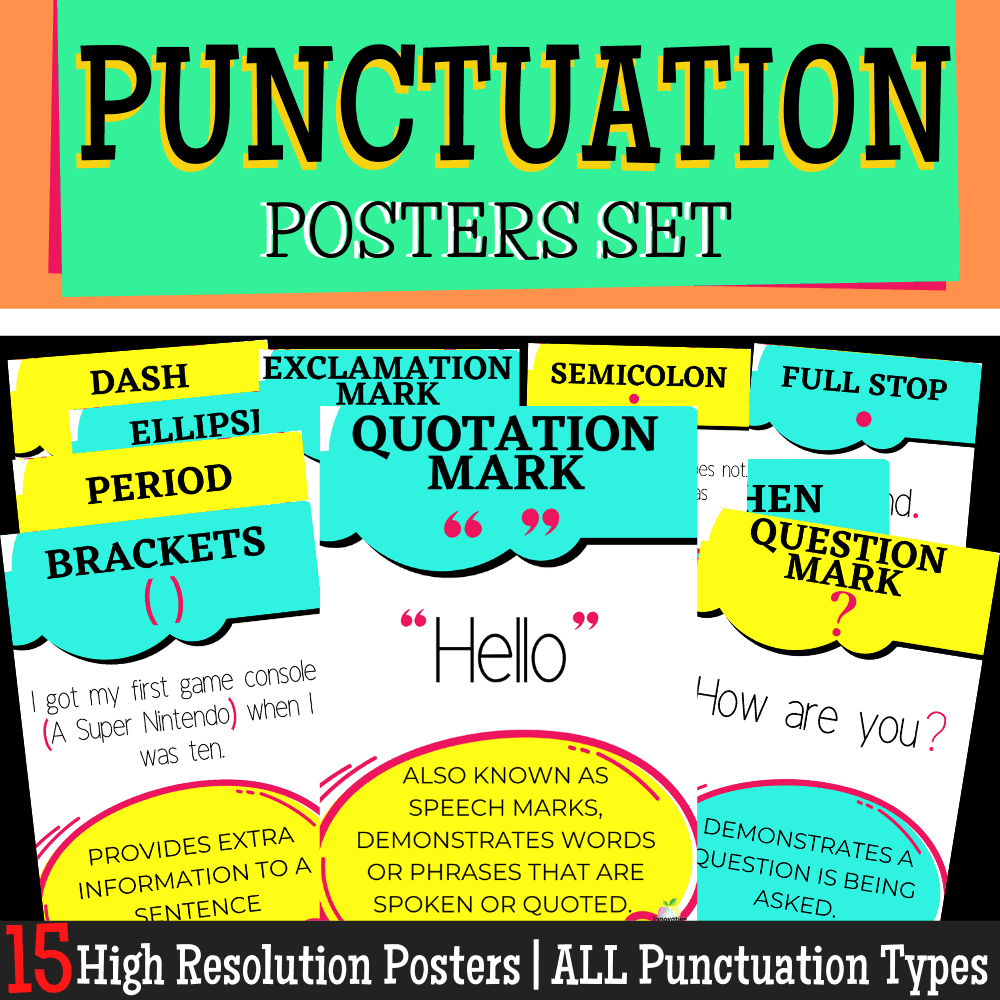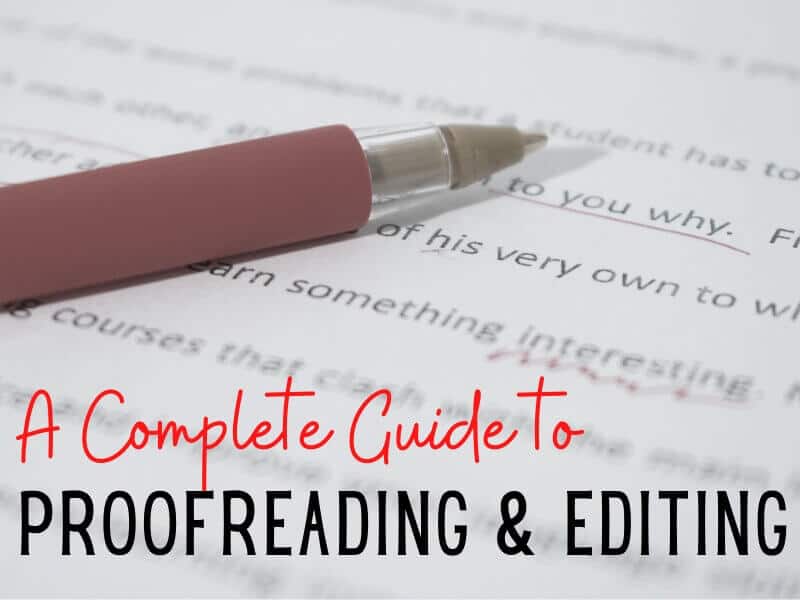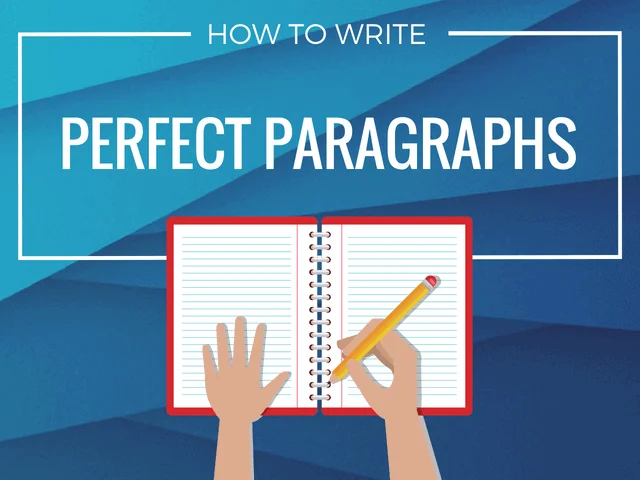
This article is part of the ultimate guide to language for teachers and students. Click the buttons below to view these.
Punctuation is the process of using recognized symbols and protocols to turn a collection of words into a logical, structured piece of writing to be read, and understood by a universal audience.
A COMPLETE GUIDE TO PUNCTUATION RULES FOR STUDENTS AND TEACHERS

We use punctuation in numerous ways to meet the purpose of your task and the needs of your audience, but essentially you are trying to achieve two outcomes.
- To make the text easier to read by adding pauses, breaks and points of emphasis.
- To add expression, detail and switch perspective when characters, and narrators are speaking.
This guide is designed to provide teachers and students with a common shared understanding of what punctuation is and how to use it effectively in all genres of writing.
It has consciously been written in simple language so that teachers can use these examples directly with students.
WHAT IS PUNCTUATION AND WHY IS IT IMPORTANT?
Punctuation refers to the set of marks that are used to regulate and clarify meaning and rhythm within a text. Punctuation helps clarify the meaning of a text by linking or separating words, phrases, clauses, and sentences.
There are approximately 14 different marks or signs that are used in this manner in English.
HOW TO TEACH PUNCTUATION
Like grammar, native English speakers will sometimes know how to use the various punctuation marks correctly in their own writing but find it challenging to explain to others.
To adequately explain to students how to use punctuation correctly, you’ll require a good understanding of English grammar and be comfortable using terms such as introductory phrases, dependent and independent clauses, coordinating and subordinating conjunctions etc.
Simply verbally outlining the rules for using the various punctuation marks is unlikely to be the most successful approach to teaching punctuation. Punctuation is all about context, and it is best to employ written examples to explain how each punctuation mark is correctly used.
Let’s take a look at five valuable tips to help with the teaching of punctuation in your classroom before we deep dive into punctuation rules with examples.
WHAT ARE THE 14 TYPES OF PUNCTUATION MARKS?
The 14 types of punctuation commonly used in English are:
- Period
- Question Mark
- Exclamation Point
- Comma
- Semicolon
- Colon
- Apostrophe
- Hyphen
- Dash
- Parentheses
- Brackets
- Quotation Marks
- Braces
- Ellipsis
DOWNLOAD OUR FREE PUNCTUATION RULES CHART AND QUICK REFERENCE GUIDE
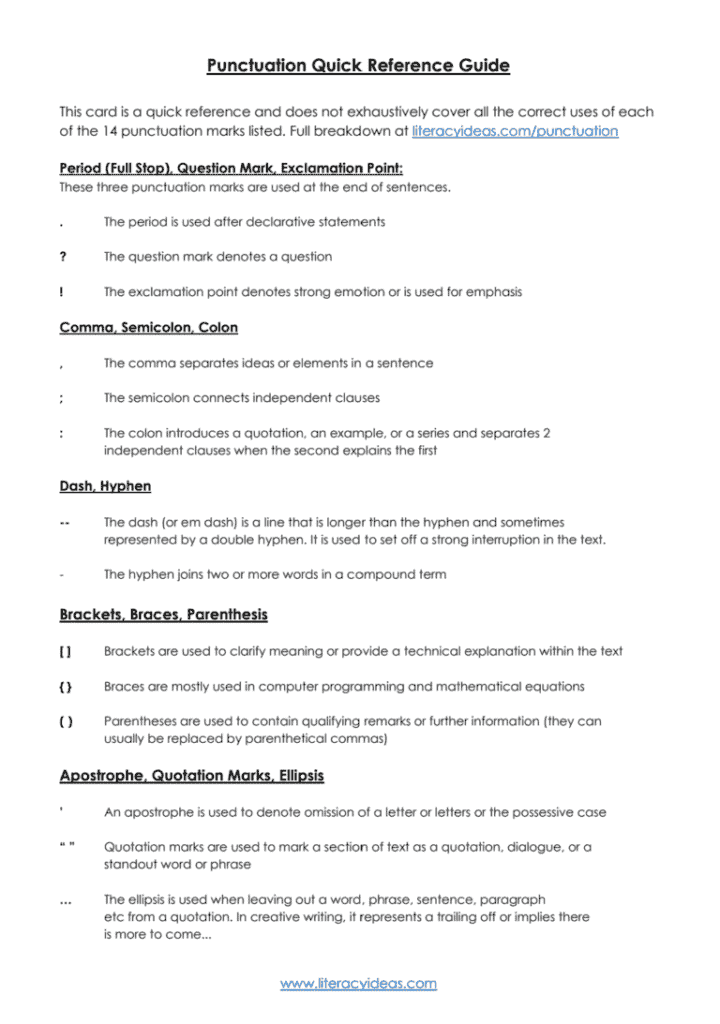
5 TIPS FOR TEACHING PUNCTUATION SUCCESSFULLY
Tip 1. Teach Grammar
Your students will likely love grammar as much as they love homework. Given the complexity of English grammar, this can be a hard sell. But, time spent mastering its vagaries will be time well-spent. Gaining a firm grasp of grammar will reap rich rewards for students in terms of understanding how to use the different forms of punctuation correctly.
It’s true, too, that English grammar can be an extremely broad area of study, so which areas should we focus on?
Developing a secure understanding of how to use punctuation correctly is nigh on impossible without first understanding dependent and independent clauses and subordinating and coordinating conjunctions. So that’s the best place to start.
Tip 2. Avoid Shortcuts
Likely, your students will have a vague understanding of how most punctuation marks will be used. However, most likely, their understanding will be superficial at best.
Often, the teacher’s students encounter in their younger years will drip feed them information regarding punctuation use in an easily digestible form and on a need-to-know basis. This information can often be so general as to be inaccurate.
Things like ‘use a comma when you need a short pause and a period when you need a longer one’ or ‘a period mark the end of a thought’, may serve some purpose for beginning writers. Still, these explanations fail to adequately explain the mechanics of how things work. Only grammar does this adequately.
Simplified explanations serve a limited purpose, and student ignorance soon gets exposed when writing at a higher level.
I speak from experience, unfortunately. An esteemed college professor once commented on an undergraduate paper of mine, “Well written and thoroughly researched. Unfortunately, the author doesn’t know a semicolon from a demisemiquaver.”
Tip 3. Employ Context
So, we’ve stressed the importance of teaching grammar as a means of communicating a clear understanding of how punctuation works. The danger of getting carried away with technical explanations is that we climb so high up on the ladder of abstraction that we leave our students stranded clueless on the ground below.
To combat this, our punctuation and grammatical explanations should always be accompanied by solid examples from written texts. This is an extension of the Show, Don’t Tell rule that creative writers love to abide by.
Tip 4. Stress Communication
We want our students to use punctuation and grammar accurately, but we don’t want them to become paralysed with fear before the “tyranny of the blank page”. Balance the need for accuracy with encouragement.
The purpose of language, written or spoken, is communication. When in doubt, suggest students abandon long, grammatically complex sentences in favour of shorter, simpler sentences that are easier to punctuate correctly.
Tip 5. Proofread, Edit…
As mentioned, striving for accuracy in punctuation is a good thing to see in our students. Sometimes, however, it can interrupt the flow of the writing process. Especially when still growing in competency. For this reason, it’s important to stress to students that punctuation should be part of the proofreading and editing process.
As students read through their work on completion, they can revise the punctuation they have used to ensure it accurately conveys the meaning they were attempting to express.
This way, writing flow is not interrupted, and writer’s block is likely avoided.
So, to review, to teach punctuation effectively:
- Ensure students have a firm understanding of the necessary rules of grammar
- Avoid using vague explanations of the rules of usage as shortcuts
- Be sure to contextualize explanations with clear examples from texts
- Stress the importance of clear communication in writing over all else
- Encourage punctuation checks as part of the editing process.
APOSTROPHES ’

Apostrophes serve two purposes in writing.
- To shorten and link connected words in what is known as a contraction.
- To show possession or ownership of something.
APOSTROPHES USED WITHIN A CONTRACTION
The purpose of an apostrophe is to indicate where a letter, or letters have been removed from a contraction.
For example
“They’re coming our way,” screamed the general, and if we don’t move now you’ll be stuck here forever.
APOSTROPHES USED TO DEMONSTRATE OWNERSHIP
An apostrophe is also used to show possession or ownership of something. To point out to the reader that this “thing” belongs to the subject being written about.
For Example
Gargamel was always searching for the Smurf’s hidden village ( The village belongs to the Smurfs )
Have you seen Eva’s school bag? (The bag belongs to Eva)
As Wendy turned and walked away you could almost hear Jimmy’s heart break in two. ( The heart belongs to Jimmy.)
BRACKETS ( ) [ ] { } / /
Depending upon the text type you are writing brackets will serve different purposes. Let’s take a look at some examples to make sense of this.
ROUND BRACKETS – ALSO KNOWN AS PARENTHESES
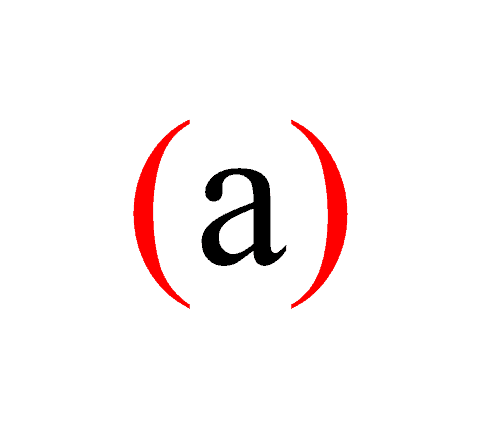
The round bracket can be used in three ways.
Using brackets to add extra information where required.
For Example
Neil Armstrong (The first person to walk on the Moon) was introduced last.
I got my first game console (A Super Nintendo) when I was ten.
Try not to get into the habit of overusing brackets to add information as a replacement for high-quality, engaging writing. For example, we could rewrite the above example like this.
“I’ ‘ll never forget my tenth birthday as I unwrapped my first game console, a Super Nintendo, which is exactly what I wanted.”
Using round brackets to indicate where information has come from when you are quoting, citing or using information directly taken from another source.
For example
“That’s one small step for man, but one giant leap for mankind.” (Neil Armstrong – 1969)
“A direct quote from a book” ( AuthorLastName, AuthorFirstname. Title. Publisher, Year. )
Using round brackets/parentheses to organize a written list.
Round brackets can be used with letters and numbers to organize lists. You can use either open or closed brackets as long as you are consistent.
For example
Items Required
a) Fishing Line
b) Coat Hanger
c) Crepe Paper
Follow these steps
(1) Remove from packaging
(2) Insert Batteries
(3) Charge the unit for 1.5 hours before use
SQUARE BRACKETS [ ]

Square brackets add information to the reader that was not explicitly stated. This is very similar to the ( ) round brackets in purpose; however, square brackets indicate this information was added by someone other than the original author. They are most commonly found within articles and non-fiction texts where an editor has made amendments.
For Example
She [Mrs. Jones] did not find it amusing
“I would have been happy with any type of dog except that one” [A poodle] she told the judge.
BRACES OR CURLY BRACKETS {

Braces or curly brackets are most commonly used in technical writing and mathematics, It is also used in written texts to branch items into sub-categories or indicate that more than one word is being referred to.
Types of Shark
{Whale Shark, Bull Shark
The range of numbers is {2, 4, 6, 8}
SLASHES \\

Slashes are rarely seen in writing. They are used to separate dates
For Example
03/11/2021
And to represent structure on a database or within a folder structure.
For example
c:\\root folder\sub folder
BULLET POINTS

Bullet points are also frequently referred to as dot points, and they are used to create lists
For example
- Milk
- Bread
- Cheese
- Tomato
- Butter
CAPITAL LETTERS A B C D E F

Capital Letters serve a number of purposes and are a foundational skill of punctuation and writing in general.
They are used to begin a sentence.
For example
The rug was dark blue.
They are used to identify a proper noun.
For example
I asked Simon to repeat the question.
The Siberian Tiger is an endangered animal.
I ran up the hill as fast as I could.
COLONS (:)

A colon is used to inform the reader that there is more detail to follow is already written. It separates two clauses and explains the first.
For example.
You will need the following items: Chalk, Paper, Scissors
She competed in four events: Archery, Athletics, Swimming and Gymnastics
COMMAS ,

Commas are used to separate words and force the reader to pause.
They are used to separate lists, phrases and clauses in sentences.
For example
At dinner we ate fish, carrots, potatoes, and rice.
Could you please bring a watch, phone, water, and a snack.
They are also used to pace a sentence to emphasise when to pause and clarify meaning.
For example
My heart was racing, I could feel the adrenaline flowing through my body. Soon, I felt my body become calm and I was ready to compete.
DASHES —

Dashes are used to emphasise a longer pause or break within a sentence, often for dramatic effect.
Don’t confuse the dash ( — ) with the hyphen. ( – ) . The dash is longer
For example
After much deliberation, the final verdict was delivered. — “Not Guilty” The judge stated confidently.
ELLIPSES …

The ellipse is constructed by creating three consecutive full stops. They serve three distinct purposes.
Using ellipses to demonstrate where speech has been interrupted.
For example
“Mum, I know you told me once …”
“I must have told you a hundred times! She interrupted.
Using ellipses to demonstrate where parts of a quote have been removed. This is done to shorten up a statement and get to the point.
For example
“Our team just didn’t have what it takes to win tonight… We played with our heads down and barely communicated.”
Finally, they are used to add dramatic effect when demonstrating a statement is incomplete. For example when someone is left speechless, or without a response.
For example
“So where did you leave your phone?” Asked dad.
“I…, I…, I just don’t know…” I replied
EXCLAMATION MARKS !
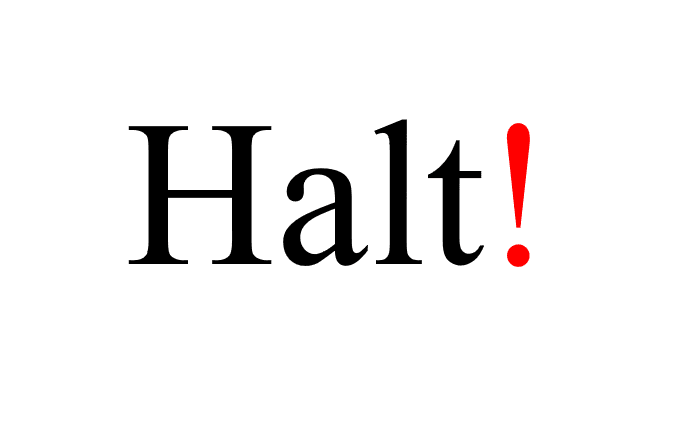
The purpose of an exclamation mark is to demonstrate strong emotions within a sentence. They help the reader to determine if a word is to be spoken with emphasis, anger or passion.
For example
“Go get em!” Yelled Coach
“Look out!” I screamed
“Because she loves you! You crazy fool!” her father exclaimed
Exclamation marks also emphasize single words to be stressed within a phrase.
I stuck my hand down the hole slowly and carefully. “Ouch!” i shrieked, as I withdrew it at lightning speed.
FULL STOPS .

The purpose of a full stop (also known as a period in the United States) is to end a sentence. To remind the reader to take pause, as this sequence of the text is complete.
Dogs are loyal animals who respect their owners.
Finally, the game had came to an unceremonious end.
HYPHENS –
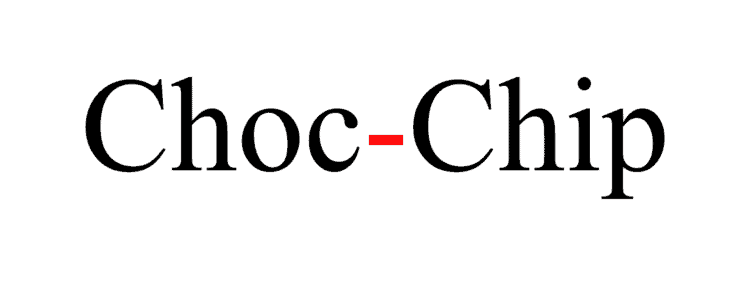
The hyphen – ( Not to be confused with the longer dash — ) is used to link words or break words into smaller parts.
For example to link connected words
It was the thirty–fifth time the club had won a title.
“I just love choc–chip ice cream.”
To link words at the end of a line
Emma was an African Croc-
odile. A big one.
Using hyphens to explain pronunciation
croc-o-dile
fun-da-men-tal
QUESTION MARKS ?

Question marks remind the audience that a question is being asked as opposed to a statement being made. Question marks are only placed at the end of a sentence.
“Are you done yet?” shouted dad.
“So, what are you going to do?” asked the quiz master
Will he ever find true love?
QUOTATION MARKS & SPEECH MARKS (“ ”) (‘ ’)

Quotation marks, also known as speech marks demonstrate to the reader words or phrases that are spoken or quoted.
It doesn’t matter if you use double or single quotation marks so long as you are consistent.
Let’s look at an example of direct speech.
“No matter what you say, I have to go back for them” I explained to my commander.
‘I’ll take the big one thanks. I’m really hungry today’ I told the waiter
Quotation marks are also used to highlight slang, strange or technical words within a sentence.
For example
My boss reminded me that this was a “no-brainer” and that I shouldn’t hesitate any longer.
My little sister called me “captain stink-face” whatever that meant.
SEMICOLONS ;

Semicolons break sentences apart for a more dramatic pause than a comma. The difference between the two is that a comma separates ideas whereas a semicolon connects ideas.
For example
We walked for hour, upon hour without seeing or hearing a single soul; then something appeared from nowhere that would change this day forever.
This day was shaping up to be the greatest day of my life; and I was conscious to enjoy it while it lasted.
Excellent punctuation tutorial video
BEAUTIFUL PUNCTUATION POSTERS FOR YOUR CLASSROOM OR STUDY
These posters are a constant visual reminder about all types of punctuation marks and how to use them.
- Dash
- Ellipse
- Exclamation Marks
- Question Mark
- Quotation Mark
- Semicolon’s
- Brackets
- Comma,
- Full Stop / Period ( Both included)
- Apostrophes
- Bullet Points
- Colon’s
- Capital Letters




